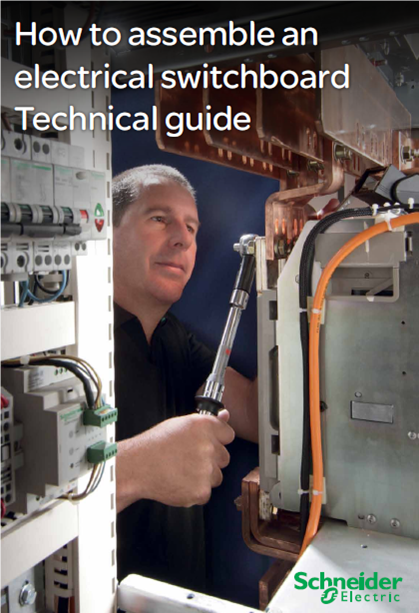Tuesday, September 3, 2013
Friday, August 30, 2013
Schneider Electric - Low voltage switchboards Quality inspection guide
1. Introduction to quality inspection
1.1. Justification for quality inspection 4
1.2. Quality inspection function 5
1.3. Quality inspection responsibility 5
1.4. Quality inspector’s profile 5
1.5. Necessary documents 5
1.6. Required human resources 5
1.7. Inspection diagram 6
2. Incoming delivery inspection
2.1. Justification for the incoming inspection 8
2.2. Procedures 9
3. In-process inspection
3.1. Inspection during manufacturing 10
3.2. Justification for the inspection
during the manufacturing stage 10
3.3. Process 11
3.4. Means 11
4. Final inspection
4.1. Final inspection process 12
4.2. Operating rules 13
4.3. Non-conformity treatment process 14
4.4. Conformity declaration 15
5. Summary of tasks after final inspection stage
5.1. Customer acceptance before installation 16
5.2. Installation 16
5.3. Commissioning 16
DOWNLOAD :
Wednesday, August 28, 2013
IK Shock-Protection Rate
IK Shock-Protection Rate
IK-Class
IK 00 No Shock-Protection
IK 01 Resistance against impacts with an energy up to 0,150 J
IK 02 Resistance against impacts with an energy up to 0,200 J
IK 03 Resistance against impacts with an energy up to 0,350 J
IK 04 Resistance against impacts with an energy up to 0,500 J
IK 05 Resistance against impacts with an energy up to 0,700 J
IK 06 Resistance against impacts with an energy up to 1,00 J
IK 07 Resistance against impacts with an energy up to 2,00 J
IK 08 Resistance against impacts with an energy up to 5,00 J
IK 09 Resistance against impacts with an energy up to 10,00 J
IK 10 Resistance against impacts with an energy up to 20,00 J
Thursday, August 22, 2013
Friday, August 16, 2013
Thursday, August 15, 2013
Overview of the main verification changes (IEC 61439 vs IEC 60439)
> Design verification
· Increased requirements for insulating materials and transient overvoltages withstand tests.
· Temperature rise verification:
ü Verification by test of each functional unit loaded alone with its rated current
ü Clear methods for the selection of representative samples of an Assembly system to be tested
ü Test done in 4 steps: individual functional units, main and distribution busbars, and complete
Assembly
ü Heating resistors only allowed to simulate circuits adjacent to a circuit under test
ü Possible verification by comparison with a tested design under strict conditions, including derating
ü Exemption of test (calculation) only allowed up to 1600 A instead of 3150 A under strict conditions,
including a 20% derating.
· Possible short-cricuit withstand verification by comparison with a tested design under strict
condition
· 200 operating cycles instead of 50 for locking, interlocking and withdrawable parts
· Lifting test (from IEC 62208)
· Corrosion resistance test for metallic parts (from IEC 62208).
> Routine verification
ü More detailed list of the verifications
ü More severe requirements for clearances
SCHNEIDER ELECTRIC
Wednesday, August 14, 2013
Tuesday, August 13, 2013
ENCLOSURE CERTIFICATES & APPROVALS
NEMA
National Electrical Manufacturers’ Association
2101 L Street Northwest, Washington, DC 20037
NEMA Standards Publication No. 250
Enclosures for Electrical Equipment (1000 Volts Maximum)
NEMA Standards Publication No. ICS6
Enclosures for Industrial Controls and Systems
UL
Underwriters' Laboratories Inc.
333 Pfingsten Road, Northbrook, Il 60062
UL 50 Cabinets and Boxes
UL 508 Industrial Control Equipment
UL 870 Wireway, Auxiliary Gutter, and Associated fittings.
CSA
Canadian Standards Association
178 Rexdale Boulevard, Rexdale, Toronto, Ontario Canada
M9W 1R3
CSA Standard C22.2, No. 14 Industrial Control Equipment
for Use in Ordinary (Non-Hazardous) Locations
CSA Standard C22.2, No. 40 Cutout, Junction,
and Pull Boxes
CSA Standard C22.2, No. 94-M91 Special Purpose
Enclosures
JIC
Joint Industry Counsel
7901 Westpark Drive, McLean, VA 22101
EMP-1 Electrical Standards for Mass Production Equipment
EGP-1 Electrical Standards for General Purpose
Machine Tools
IEC
International Electrotechnical Commission
3 Rue de Varemb, CH-1211
Geneva 20, Switzerland
IEC 529 Classification of Degrees of Protection
Provided by Enclosures
ANSI
American National Standards Institute
1430 Broadway
New York, NY 10018
ANSI Z55.1-1967 Gray Finishes for Industrial
Apparatus and Equipment
EEMAC
Electrical/Electronic Manufacturers Association of Canada
10 Carlson Court
Suite 500
Rexdale (Toronto), Ontario Canada M9W 6L2
TUV
TUV Rheinland
Glenview, IL
Newtown, CT
San Ramon, CA
VDE
Institute of German Electronics Engineers
Merianstrasse 28
D-6050 Offenbach, Germany
EIA
Electronic Industries Association
2001 Eye Street Northwest
Washington, DC 20006
EIA RS-310-D Racks, Panels, and Associated Equipment
NFPA
National Fire Protection Association
Batterymarch Park
Quincy, MA 02269
NFPA 70 National Electrical Code
More Info :
What is IP69K?
The IP69K rating is for applications where high pressure and high temperature wash down is used to sanitize equipment.
The IP69K test specification was initially developed for road vehicles, especially those that need regular intensive cleaning (dump trucks, cement mixers, etc), but has been widely adopted in the Food & Beverage industries as a test of products to withstand sanitary washdown.
What does IP69K mean?
In the IEC 60529 rating system, IP6 refers to the product’s ability to resist ingress of dust. The 69K refers to the product’s ability to resist ingress of high temperature (Steam)/high pressure water.
How is the product tested?*
• Products rated to IP69K must be able to withstand high-pressure and steam cleaning.
• The test specifies a spray nozzle that is fed with 80 °C water at 80–100 bar (~1160-1450) and a flow rate of 14–16 L/min.
• The nozzle is held 10–15 cm from the tested device at angles of 0°, 30°, 60° and 90° for 30 seconds each.
• The test device sits on a turntable that rotates once every 12 seconds








